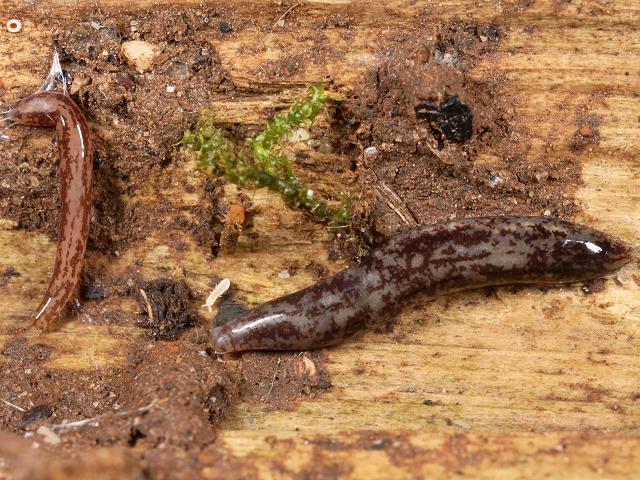
APHOTOFAUNA
An online educational resource dedicated to the photography of
terrestrial wildlife and their habitats, found across South-West
England and the Devon and Cornwall Peninsula by David Fenwick.
Argonemertes sp. (c.f. A. australiensis) - A non-native terrestrial nemertine or Smiling worm
Scroll down and rollover titles to change screen image or click on title to view image.
Please note the following species has been DNA sequenced at the Natural History Museum to try and determine the species. The species is not kown but we do know the COI. Other worms found may or may not be the same species as nemertines can externally be extremely variable. This particular species looks like Argonemertes australiensis. A lot more work needs to be done to determine how many similar looking cryptic species might be found in the UK.
New species need to be described and named, the problem is there are very few people that can do this.
Non-native terrestrial nemertine
Argonemertes sp. (c.f. Argonemertes australiensis)
- mature 1
Non-native terrestrial nemertine
Argonemertes sp. (c.f. Argonemertes australiensis)
- top view 1
Specimen one: 10mm long alien species found under an old brick radiator tile at Roscadghill Parc, Heamoor, Penzance, Cornwall. 17.05.13. (Specimen One).
Non-native terrestrial nemertine
Argonemertes sp. (c.f. Argonemertes australiensis)
- top view 1
Non-native terrestrial nemertine
Argonemertes sp. (c.f. Argonemertes australiensis)
- top view 2
Non-native terrestrial nemertine
Argonemertes sp. (c.f. Argonemertes australiensis)
- top view 3
Non-native terrestrial nemertine
Argonemertes sp. (c.f. Argonemertes australiensis)
- eye spots 1
Non-native terrestrial nemertine
Argonemertes sp. (c.f. Argonemertes australiensis)
- proboscis 1
Specimen two: found under a piece of old rotting timber at Roscadghill Parc, Heamoor, Penzance, Cornwall. 30.05.13. Specimen Two).
Non-native terrestrial nemertine
Argonemertes sp. (c.f. Argonemertes australiensis)
- top view 1
Non-native terrestrial nemertine
Argonemertes sp. (c.f. Argonemertes australiensis)
- top view 2
Non-native terrestrial nemertine
Argonemertes sp. (c.f. Argonemertes australiensis)
- top view 3
Non-native terrestrial nemertine
Argonemertes sp. (c.f. Argonemertes australiensis)
- proboscis 1
Non-native terrestrial nemertine
Argonemertes sp. (c.f. Argonemertes australiensis)
- proboscis 2
Specimen found under a second piece of old rotting timber at Roscadghill Parc, Heamoor, Penzance, Cornwall. 30.05.13. (Specimen Three)
Non-native terrestrial nemertine
Argonemertes sp. (c.f. Argonemertes australiensis)
- top view 1
Non-native terrestrial nemertine
Argonemertes sp. (c.f. Argonemertes australiensis)
- top view 2
Non-native terrestrial nemertine
Argonemertes sp. (c.f. Argonemertes australiensis)
- top view 3
Non-native terrestrial nemertine
Argonemertes sp. (c.f. Argonemertes australiensis)
- proboscis 1
Specimen found under a piece of rotting plywood at Penzance Cemetery, Penzance, Cornwall. 13.06.13. (Specimen Four)
Non-native terrestrial nemertine
Argonemertes sp. (c.f. Argonemertes australiensis)
- under rock 1
Non-native terrestrial nemertine
Argonemertes sp. (c.f. Argonemertes australiensis)
- under rock 2
Non-native terrestrial nemertine
Argonemertes sp. (c.f. Argonemertes australiensis)
- under rock 3
Above specimens found under rocks at Morrab Sub-tropical Gardens, Penzance, Cornwall. 18.10.13 and 17.10.13. (Specimen Five).
So far this species has only been recorded at three sites around Penzance, Cornwall. The sites are one mile apart as the crow flies. A major road and many other minor roads separate sites. It remains unclear how long the species has been in the UK and how it has got from one site to another. Transfer by plant exchange or sale is unlikely, unless the species is hugely under-recorded in the local area or region. We cannot be sure on what it feeds, but bug nymphs, mites and springtails are likely to be its main source of food.
APHOTOFAUNA supports open source data recording and sharing for the benefit of wildlife, recorders, research, science and education. The project works closely with the following bodies and organisations.
The CISFBR or Cornwall and Isles of Scilly Federation of Biological Recorders is an independent umbrella organisation supporting independent recorders and recording groups in the county of Cornwall.
The Cornish Biodiversity Network or CBN is the largest open source wildlife database in Cornwall that sends open source data to the NBN (National Biodiversity Network). It is a new recording system based on the ERICA database, the largest recording resource in Cornwall. The CBN best supports the activities and needs of the independent recording community and recording groups in Cornwall.
The National Biodiversity Network or NBN is a charity that supports open source data sharing and recording supporting conservation, science and education.
"Why do recorders need open source?". Simply because it supports the core values of wildlife recording and the free use of records and data over a very wide network that includes partners like the Natural History Museum.

The main objective of this website is in furthering environmental awareness and education through the medium of photography. To increase awareness and access to the wildlife of the region and help
people find and identify it. Sometimes the difference between species is obvious but many species can only be determined by observing microscopic characteristics that are specific to any one species.


